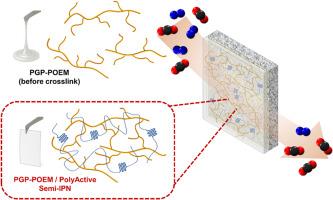Polymer-blend thin-film composite membranes with semi-IPN architecture for enhanced CO2 separation and mechanical robustness
IF 9
1区 工程技术
Q1 ENGINEERING, CHEMICAL
引用次数: 0
Abstract
Scalable thin-film composite (TFC) membranes with high CO2 separation performance and robust mechanical durability are essential for industrial carbon capture. In this study, we present the design and fabrication of fully polymeric, high-performance TFC membranes based on a semi-interpenetrating polymer network (semi-IPN) architecture. A self-crosslinkable, comb-shaped copolymer—poly(glycidyl methacrylate-g-polypropylene glycol)-co-poly(oxyethylene methacrylate) (PGP-POEM)—was synthesized as a CO2-selective matrix. To mitigate tackiness and improve mechanical strength, a small amount of commercial Polyactive was blended, forming a miscible semi-IPN with strong compatibility and synergistic interactions. Molecular dynamics (MD) simulations were employed to analyze free volume, thermodynamic miscibility, CO2 affinity, diffusivity, and solubility. The optimized membrane containing 25 wt% Polyactive exhibited a CO2 permeance of 1482 GPU and a CO2/N2 selectivity of 36.3, meeting benchmarks for post-combustion capture. Additionally, the membranes demonstrated excellent mechanical properties, with a tensile modulus of 1.15 MPa and an elongation at break of 161 %, while maintaining a non-tacky surface. These results highlight the potential of the semi-IPN approach as a scalable and cost-effective strategy for advanced gas separation membranes.

具有半ipn结构的聚合物共混薄膜复合膜,用于增强CO2分离和机械坚固性
具有高CO2分离性能和坚固机械耐久性的可伸缩薄膜复合材料(TFC)膜对于工业碳捕获至关重要。在这项研究中,我们提出了基于半互穿聚合物网络(半ipn)结构的全聚合物高性能TFC膜的设计和制造。合成了一种自交联的梳状共聚物-聚(甲基丙烯酸缩水甘油酯-g-聚丙烯乙二醇)-共聚(甲基丙烯酸氧乙烯)(PGP-POEM)作为co2选择性基质。为了降低粘滞性和提高机械强度,将少量的商业聚活性混合在一起,形成具有强相容性和协同作用的混相半ipn。分子动力学(MD)模拟分析了自由体积、热力学混相、CO2亲和性、扩散率和溶解度。含有25 wt%聚活性的优化膜的CO2渗透率为1482 GPU, CO2/N2选择性为36.3,满足燃烧后捕获的基准。此外,该膜表现出优异的机械性能,拉伸模量为1.15 MPa,断裂伸长率为161%,同时保持表面不粘。这些结果突出了半ipn方法作为先进气体分离膜的可扩展和成本效益策略的潜力。
本文章由计算机程序翻译,如有差异,请以英文原文为准。
求助全文
约1分钟内获得全文
求助全文
来源期刊

Journal of Membrane Science
工程技术-高分子科学
CiteScore
17.10
自引率
17.90%
发文量
1031
审稿时长
2.5 months
期刊介绍:
The Journal of Membrane Science is a publication that focuses on membrane systems and is aimed at academic and industrial chemists, chemical engineers, materials scientists, and membranologists. It publishes original research and reviews on various aspects of membrane transport, membrane formation/structure, fouling, module/process design, and processes/applications. The journal primarily focuses on the structure, function, and performance of non-biological membranes but also includes papers that relate to biological membranes. The Journal of Membrane Science publishes Full Text Papers, State-of-the-Art Reviews, Letters to the Editor, and Perspectives.
 求助内容:
求助内容: 应助结果提醒方式:
应助结果提醒方式:


